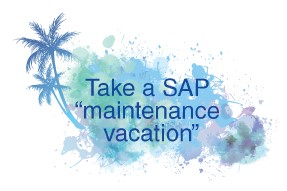 Managing risk and containing costs are two CFO responsibilities that intersect when it comes to SAP maintenance contracts. SAP charges customers up to 22% of the original licensing fee each year for support and maintenance, and in some cases, annual increases are built into the maintenance contract’s automatic renewal clause. Those using SAP for support and maintenance have often felt pressured to upgrade to costly new versions or to prematurely migrate to HANA. This has been known to create a state of perpetual instability with limited value to the business.
Managing risk and containing costs are two CFO responsibilities that intersect when it comes to SAP maintenance contracts. SAP charges customers up to 22% of the original licensing fee each year for support and maintenance, and in some cases, annual increases are built into the maintenance contract’s automatic renewal clause. Those using SAP for support and maintenance have often felt pressured to upgrade to costly new versions or to prematurely migrate to HANA. This has been known to create a state of perpetual instability with limited value to the business.
It is well documented that software maintenance revenues generate up to 90% of the gross margin contribution to companies such as SAP. Rather than allowing your SAP maintenance and support agreement to renew automatically for 2017, now is the time to review your options. As we’ve mentioned before, there are numerous reasons to switch to third-party support providers, including an average annual savings of 62%, faster response times, core and custom code expertise on current and older versions of SAP software, global tax and regulatory compliance management, and so on.
We recommend CFOs take the following steps before you end up committed to SAP support for another year:
1. Review your contract
Confer with corporate counsel and engage third-party SAP contract experts and analysts.
2. Get feedback from key stakeholders
Keeping the C-Suite and IT department in the loop helps uncover issues and builds buy-in should SAP contact them directly after the cancellation is submitted.
3. Cancel on time and follow correct procedures
SAP will reject the notice if it’s not submitted according to guidelines, so pay specific attention to the following terms and conditions:
- Maintenance expiration date.
- Required notice period (usually 90 days) and notification method (e.g., written letter).
- Legal notification address (along with name and title, if specified).
If you are in discussion with a third-party vendor like Spinnaker Support, but not 100% sure you are leaving SAP, still submit a cancellation. Notice of cancellation is a strong negotiating tactic.
4. Be prepared to negotiate
SAP may counter your cancellation, and counteroffers could include:
- A new license (e.g., cloud) that you can’t use yet, and will have to pay to implement once you can use it.
- A lower level of support for a lower fee.
- Partial termination of licenses. This termination may result in a re-pricing of the maintenance costs for your remaining products, negating any savings. And by surrendering licenses, you concede your perpetual license (an asset) and forfeit rights to use those licenses in the future.
5. Be prepared for threats and intimidation
Some software publishers have been known to use scare tactics to keep you from switching including:
- Inability to buy new licenses. Even if your contract states you cannot buy directly from SAP, there are SAP resellers.
- Return penalties. Check your contract to see if there are penalties (e.g., back maintenance fees) for terminating the contract or returning unused licenses.
- Losing access to Solution Manager. SAP offers Service Marketplace, which enables customers who are no longer on maintenance agreements to install software to which they have rights and have archived prior to the SAP maintenance expiration/termination date.
6. Make a transition plan
If you’ve chosen to go with a third-party support provider, they will supply onboarding and archiving tools, tips, and processes to keep things from falling through the cracks. Be sure to look at the backlog of tickets with SAP that won’t get resolved before the contract expires and share them on to your new third-party partner. Also look into any SAP updates that will come out during your transition period.
Reducing risks and lowering costs offers short-term and long-term benefits for your company. Switching from a SAP maintenance contract to a third-party support provider can accomplish both at the same time. Take a SAP maintenance vacation to help fund your IT roadmap or cloud migration strategy.